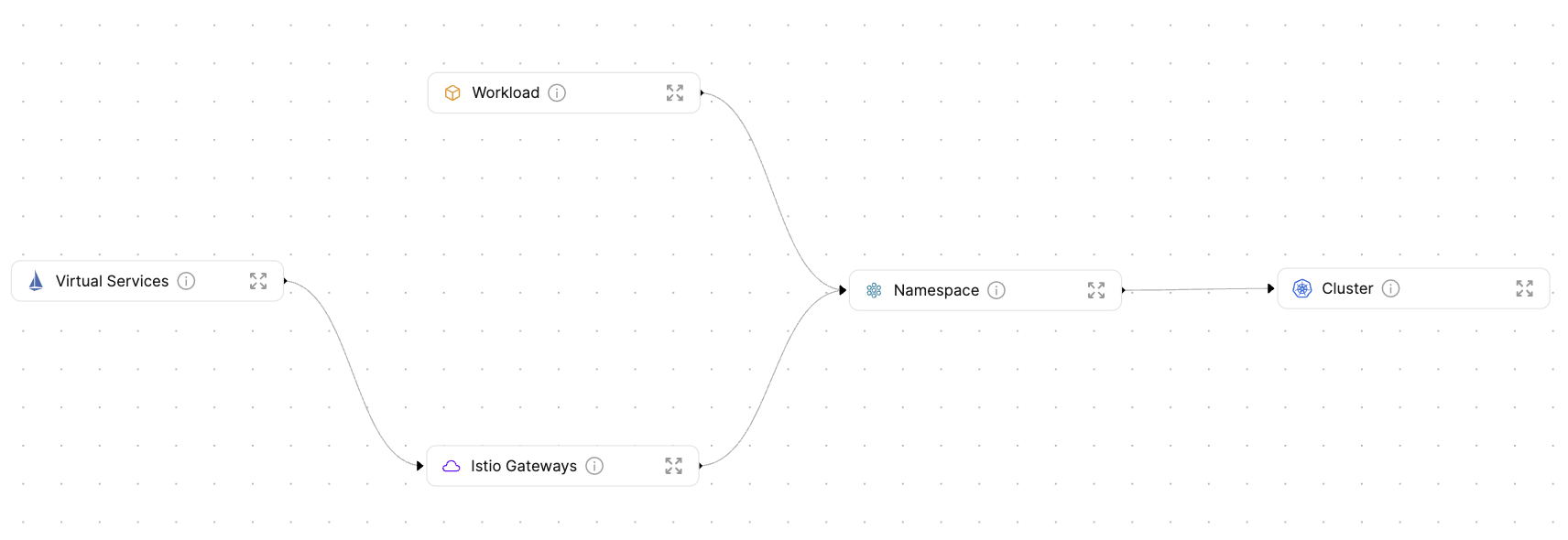Istio
Istio is an open-source service mesh that provides a uniform way to connect, manage, and secure microservices.
Using Port's Kubernetes Exporter, you can keep track of all Istio resources across your different clusters and export all the data to Port. You will use built in metadata from your kubernetes resources and CRDs to create Entities in Port and keep track of their state.
Get to know the basics of our Kubernetes exporter here!

Prerequisites
- This guide assumes you have completed the visualize your services' k8s runtime guide
- Helm must be installed to use the chart. Please refer to Helm's documentation to get started
- The
jqcommand must installed - The
yqcommand must installed - The
kubectlcommand must be installed - Have your Port credentials ready.
In this use-case, you will use a custom bash script which will assist you in the process of installing Port's K8s exporter.
The script will install the helm chart to the Kubernetes cluster which is currently in kubectl context. To view the context name of the cluster the exporter will be installed on, run:
kubectl config current-context
Setting up blueprints & resource mapping
The following section will guide you through the process of setting up your blueprints and resource mapping using the installation script. You can read more about the installation script here.
Creating blueprints
The installation script provides a convenient way to create your blueprints. Using the CUSTOM_BP_PATH environment
variable, you can fetch a pre-defined blueprints.json to create your blueprints. For this use-case, you will
use this file to
define your blueprints. Do this by running:
export CUSTOM_BP_PATH="https://raw.githubusercontent.com/port-labs/template-assets/main/kubernetes/blueprints/istio-blueprints.json"
This blueprints.json file defines the following blueprints:
- Cluster
- Namespace
- Workload
- Istio Gateway
- Istio Virtual Service
-
Workloadis an abstraction of Kubernetes objects which create and manage pods. By creating this blueprint, you can avoid creating a dedicated blueprint per Workload type, all of which will likely look pretty similar. Here is the list of kubernetes objectsWorkloadwill represent:- Deployment
- ReplicaSet
- StatefulSet
- DaemonSet
Below are the Istio blueprint schemas used in the exporter:
Istio gateway blueprint (click to expand)
{
"identifier":"gateways",
"description":"This blueprint represents a service in our software catalog",
"title":"Istio Gateways",
"icon":"Cloud",
"schema":{
"properties":{
"name":{
"type":"string"
},
"ports":{
"type":"array"
},
"labels":{
"type":"object"
},
"selector":{
"type":"object"
}
},
"required":[]
},
"mirrorProperties":{},
"calculationProperties":{},
"relations":{
"namespace":{
"target":"namespace",
"required":true,
"many":false
}
}
}
Istio virtual service blueprint (click to expand)
{
"identifier":"virtualServices",
"description":"This blueprint represents a service in our software catalog",
"title":"Virtual Services",
"icon":"Istio",
"schema":{
"properties":{
"hosts":{
"type":"array"
},
"match":{
"type":"array"
},
"labels":{
"type":"object"
}
},
"required":[]
},
"mirrorProperties":{},
"calculationProperties":{},
"relations":{
"gateways":{
"target":"gateways",
"many":true
}
}
}
Exporting custom resource mapping
Using the CONFIG_YAML_URL parameter, you can define a custom resource mapping to use when installing the exporter.
In this use-case you will be using the this configuration file. To achieve this, run:
export CONFIG_YAML_URL="https://raw.githubusercontent.com/port-labs/template-assets/main/kubernetes/templates/istio-kubernetes_v1_config.yaml"
Below is the mapping for the Istio resources:
Istio gateway mapping (click to expand)
- kind: networking.istio.io/v1beta1/gateways
port:
entity:
mappings:
- identifier: .metadata.name + "-" + .metadata.namespace
blueprint: '"gateways"'
properties:
title: .metadata.name
ports: .spec.servers[].port.number
name: .metadata.name
labels: .metadata.labels
selector: .spec.selector
relations:
namespace: .metadata.namespace
Istio virtual service mapping (click to expand)
- kind: networking.istio.io/v1beta1/virtualservices
port:
entity:
mappings:
- identifier: .metadata.name + "-" + .metadata.namespace
blueprint: '"virtualServices"'
properties:
title: .metadata.name
hosts: .spec.hosts
match: .spec.http[].match
labels: .metadata.labels
relations:
gateways: .spec.gateways[] + "-" + .metadata.namespace
services: .metadata.namespace as $namespace | .spec.http[].route[].destination.host + "-" + $namespace
You can now browse to your Port environment to see that your blueprints have been created, and your k8s and Istio resources are being reported to Port using the freshly installed k8s exporter.